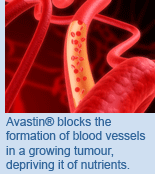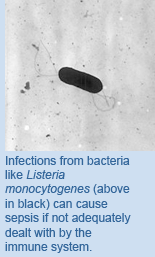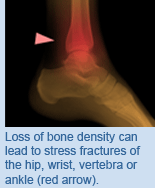
January 2012
Welcome to Net Results EXPRESS
Net Results EXPRESS (NRx) is an award-winning, monthly e-newsletter highlighting medical and scientific breakthroughs, major grants and honours awarded, and other research-related events at UHN. Through NRx you can read about ongoing research at our five research institutes, the Ontario Cancer Institute (OCI), the Toronto General Research Institute (TGRI), the Toronto Western Research Institute (TWRI), the Toronto Rehabilitation Institute (TRI) and the Techna Institute for the Advancement of Technology for Health (Techna). We hope you will find this newsletter informative and helpful. If you have feedback or questions, please contact www@uhnresearch.ca. Christopher J. Paige, PhD, FCAHS |
Ovarian Cancer: Drug Delays Disease Progression
The international clinical trial, co-led by OCI Clinician Scientist Dr. Amit Oza, examined 1,528 women with ovarian cancer over a period of seven years. Avastin® was administered intravenously every three weeks for a period of 12 months and results demonstrated that its administration held off disease recurrence for two months. For women with the highest disease risk, the delay was five to six months. The findings also indicate a strong trend to improved overall survival, which is currently undergoing investigation in a clinical trial ending in 2013. "This is the first new drug for ovarian cancer in 15 years to show improved outcome and I believe it should be considered as a potential new standard of care," says Dr. Oza. A phase 3 trial of bevacizumab in ovarian cancer. Perren TJ, Swart AM, Pfisterer J, Ledermann JA, Pujade-Lauraine E, Kristensen G, Carey MS, Beale P, Cervantes A, Kurzeder C, du Bois A, Sehouli J, Kimmig R, Stähle A, Collinson F, Essapen S, Gourley C, Lortholary A, Selle F, Mirza MR, Leminen A, Plante M, Stark D, Qian W, Parmar MK, Oza AM; ICON7 Investigators. New England Journal of Medicine. 2011 Dec 29. [Pubmed abstract] This work was supported by the Medical Research Council UK, Roche, the National Institute of Health, the National Cancer Research Network and The Princess Margaret Hospital Foundation. |
Immunity: Regulating the Response to Infection
The protein iRhom2 was found to regulate the release of Tumour Necrosis Factor alpha (TNFα), a protein that promotes inflammation in response to infections. In fact, mice lacking iRhom2 survived lipopolysaccharide treatment, a toxin known to cause sepsis, due to decreased levels of TNFα. To highlight the importance of iRhom2 and the innate immune response, mice lacking iRhom2 were unable to control an infection of Listeria monocytogenes—a foodborne bacteria responsible for serious infections in humans. Commenting on the study, Dr. Mak says, "Our characterization of iRhom2's role in the innate immune response system has yielded two important findings. We have a better understanding of the initial response system to infections and we have a potential new therapeutic approach for treating TNFα-mediated diseases." iRhom2 regulation of TACE controls TNF-mediated protection against Listeria and responses to LPS. McIlwain DR, Lang PA, Maretzky T, Hamada K, Ohishi K, Maney SK, Berger T, Murthy A, Duncan G, Xu HC, Lang KS, Häussinger D, Wakeham A, Itie-Youten A, Khokha R, Ohashi PS, Blobel CP, TW Mak. Science. 2012 Jan 12. [Pubmed abstract] This work was supported by the Canadian Institutes of Health Research, the Terry Fox Foundation and The Princess Margaret Hospital Foundation. |
Hormone Therapy: Ontario Failing to Treat Osteoporosis-Related Side Effects
To gauge whether the risk of osteoporosis is accurately addressed in patients undergoing ADT, the study looked at the incidence rate of bone mineral density (BMD) tests for these patients. While the number of BMD tests was found to increase over the period between 1998 and 2008, the overall rate was low. In the 4% of men in the study that were previously diagnosed with osteoporosis, the majority did not receive BMD testing. While the importance of BMD monitoring for patients being treated with ADT is recognized in Canada, the results of this study show that Ontario lacks proper guidelines for these patients. Furthermore, the study illustrates that Ontario health care practitioners need to be alerted to the importance of monitoring and treating these serious yet preventable side effects. Screening for osteoporosis in men receiving androgen deprivation therapy. Alibhai SM, Yun L, Cheung AM, Paszat L. Journal of the American Medical Association. 2012 Jan 18. [Pubmed abstract] This work was supported by the Toronto General & Western Hospital Foundation and the Canadian Cancer Society. |
Metabolism: How the Gut Controls Glucose Production
The research team reported that activation of a particular protein, cAMP-dependent protein kinase (PKA), in the duodenum was sufficient to lower glucose production. This was found to occur through the actions of vagal nerves that innervate the intestine—these are the nerves responsible for communicating information from the abdominal organs to the brain. Using an experimental model for obesity and diabetes, they also found that treatment with a drug that activated PKA (Sp-CAMPS) lowered glucose production through the described system. Commenting on the importance of this study, Dr. Lam said, "Through the use of duodenal Sp-CAMPS, we can activate the neuronal network responsible for lowering glucose production and potentially help restore correct glucose production in diabetes and obesity." Duodenal activation of cAMP-dependent protein kinase induces vagal afferent firing and lowers glucose production in rats. Rasmussen BA, Breen DM, Luo P, Cheung GW, Yang CS, Sun B, Kokorovic A, Rong W, Lam TK. Gastroenterology. 2012 Jan 12. [Pubmed abstract] This work was supported by the Canadian Institutes of Health Research, the Science and Technology Commission of Shanghai Municipality, the Shanghai Municipality Education Commission and the Canada Research Chairs program. |
Immunology: A New Model for Injury Repair in the Eye
By examining a type of tissue in the eye called the epithelium, the team observed an increase in a specific protein—vascular endothelial growth factor-A—and significant growth of new blood vessels at the site of injury. This occurred in the first three days, prior to the development of a robust immune response and the release of cytokines—proteins of the immune system that promote inflammation. Thus, contrary to the current model, researchers believe that the initial response leading to the development of CoNV is coordinated first by the repair epithelial cells, and not the recruitment of inflammatory response cells. "This work reveals a window in which new blood vessel formation and inflammation play separate roles during injury repair," explains Dr. Sivak. "Development of pharmacological tools that can inhibit different aspects of these injuries may enable more appropriate therapies." Pharmacologic uncoupling of angiogenesis and inflammation during initiation of pathological corneal neovascularization. Sivak, JM, Ostriker AC, Woolfenden A, Demirs J, Cepeda R, Long D, Anderson K, Jaffee B. The Journal of Biological Chemistry. 2011 Dec 30. [Pubmed abstract] This work was supported by the Novartis Institutes for Biomedical Research and the Toronto General & Western Hospital Foundation Glaucoma Research Chair. |
Social Media: The Role of Twitter in Assessing Scientific Impact
The study examined all Twitter references (tweets) to scientific articles published in the Journal of Medical Internet Research between July 2008 and November 2011 and compared them to citation data from two of the largest citation databases, Scopus and Google Scholar. Articles receiving the most tweets were found to be 11 times more likely to be highly cited. Commenting on the use of Twitter in predicting scientific impact, Dr. Eysenbach says, "These findings suggest that social impact measures based on tweets complement traditional citation metrics. The proposed 'twimpact' factor may be a useful and timely metric to measure the uptake of research findings and to filter research findings resonating with the public in real time." Can tweets predict citations? Metrics of social impact based on twitter and correlation with traditional metrics of scientific impact. Eysenbach G. Journal of Medical Internet Research. 2011 Dec 19. [Article]
|
 |
![]()
 This past December, OCI Senior Scientist Dr. Alex Vitkin was elected a Fellow of the Optical Society of America (OSA). Dr. Vitkin is recognized for his contributions to the field of biophotonics and biomedical optics. His work has involved the development of novel methodologies in polarized light assessment of tissues, optical coherence tomography for microvascular detection, and optical fiber sensors for treatment monitoring and guidance.
This past December, OCI Senior Scientist Dr. Alex Vitkin was elected a Fellow of the Optical Society of America (OSA). Dr. Vitkin is recognized for his contributions to the field of biophotonics and biomedical optics. His work has involved the development of novel methodologies in polarized light assessment of tissues, optical coherence tomography for microvascular detection, and optical fiber sensors for treatment monitoring and guidance.Founded in 1916, OSA is the world’s leading society for the development and promotion of optics and photonics. OSA serves to support research, promote technical and professional development and advance technologies made possible by optics.
 Congratulations to Dr. Charles Tator, TWRI Senior Scientist, who is the recipient of the 2012 Council Award from the College of Physicians and Surgeons of Ontario in recognition of his achievements in neurosurgery research, education, teaching and advocacy.
Congratulations to Dr. Charles Tator, TWRI Senior Scientist, who is the recipient of the 2012 Council Award from the College of Physicians and Surgeons of Ontario in recognition of his achievements in neurosurgery research, education, teaching and advocacy. Dr. Eleftherios Diamandis, Biochemist-in-Chief of UHN’s Department of Clinical Biochemistry, was elected as a Fellow of the American Association for the Advancement of Science (AAAS) in recognition of his contributions to the field of genomics and pathobiology of serine proteases, particularly the kallikrein family, and their application as diagnostic cancer biomarkers.
Dr. Eleftherios Diamandis, Biochemist-in-Chief of UHN’s Department of Clinical Biochemistry, was elected as a Fellow of the American Association for the Advancement of Science (AAAS) in recognition of his contributions to the field of genomics and pathobiology of serine proteases, particularly the kallikrein family, and their application as diagnostic cancer biomarkers.AAAS is the world's largest general scientific society with a mission to "advance science and serve society" through initiatives that include science policy, international programs, science education and public understanding of science. Dr. Diamandis will be recognized for his contributions at the Fellows Forum to be held on February 18th, 2012 during the AAAS Annual Meeting in Vancouver, British Columbia.
 Dr. Rosemary Martino, TWRI Affiliate Scientist, was elected President of the Dysphagia Research Society (DRS) for the term of 2011-2012. DRS is organized for the educational and scientific purposes of encouraging research and disseminating knowledge related to normal and disordered swallowing and fostering new methodologies and instrumentation in dysphagia research and its clinical applications. Dr. Martino previously served as a Councillor (2008-09), Secretary/Treasurer (2009-10) and Chair of Abstracts (2010-11) preceding her election.
Dr. Rosemary Martino, TWRI Affiliate Scientist, was elected President of the Dysphagia Research Society (DRS) for the term of 2011-2012. DRS is organized for the educational and scientific purposes of encouraging research and disseminating knowledge related to normal and disordered swallowing and fostering new methodologies and instrumentation in dysphagia research and its clinical applications. Dr. Martino previously served as a Councillor (2008-09), Secretary/Treasurer (2009-10) and Chair of Abstracts (2010-11) preceding her election.Feedback
Net Results EXPRESS is brought to you by UHN Research Communications. We hope you have enjoyed receiving this message. If you have any feedback, please email www@uhnresearch.ca.
To access archived issues of Net Results EXPRESS, visit uhnresearch.ca/news/netresultsexpress
Some images adapted from the image archives of stock.xchng.ca. Preliminary findings, published in the New England Journal of Medicine, have shown that treatment of ovarian cancer patients with the drug bevacizumab (Avastin®) delays disease progression and may improve patient survival.
Preliminary findings, published in the New England Journal of Medicine, have shown that treatment of ovarian cancer patients with the drug bevacizumab (Avastin®) delays disease progression and may improve patient survival. A study from the Campbell Family Institute for Breast Cancer Research Director Dr.
A study from the Campbell Family Institute for Breast Cancer Research Director Dr.  Of all men diagnosed with prostate cancer it is anticipated that half receive androgen deprivation therapy (ADT), in which male sex hormones are reduced in order to slow disease progression. A serious side effect of ADT is loss of bone density and increased risk of fractures—conditions that are treatable if properly monitored. A study led by TRI Scientist and TGRI Senior Scientist Dr.
Of all men diagnosed with prostate cancer it is anticipated that half receive androgen deprivation therapy (ADT), in which male sex hormones are reduced in order to slow disease progression. A serious side effect of ADT is loss of bone density and increased risk of fractures—conditions that are treatable if properly monitored. A study led by TRI Scientist and TGRI Senior Scientist Dr.  Diabetes is characterized, in part, by a disruption in the control of glucose production. The duodenum—the first section of the small intestine—responds to food entering the gut by lowering glucose production accordingly. However, how the duodenum communicates with the nervous system to control glucose production remains a mystery. In a new study published in Gastroenterology, TGRI Scientist Dr.
Diabetes is characterized, in part, by a disruption in the control of glucose production. The duodenum—the first section of the small intestine—responds to food entering the gut by lowering glucose production accordingly. However, how the duodenum communicates with the nervous system to control glucose production remains a mystery. In a new study published in Gastroenterology, TGRI Scientist Dr.  In mammals, the cornea acts both as a medium that allows light to travel inside the eye and as an external barrier protecting the eye from the surrounding environment. Injury to the eye can cause a condition termed pathological corneal neovascularization (CoNV)—an overwhelming inflammatory response resulting in the rapid growth of blood vessels that can lead to clouding of the cornea and significant vision loss. TWRI Scientist Dr.
In mammals, the cornea acts both as a medium that allows light to travel inside the eye and as an external barrier protecting the eye from the surrounding environment. Injury to the eye can cause a condition termed pathological corneal neovascularization (CoNV)—an overwhelming inflammatory response resulting in the rapid growth of blood vessels that can lead to clouding of the cornea and significant vision loss. TWRI Scientist Dr.  The number of times a published, peer-reviewed article is referred to by other publications, known as a citation, is a common method to evaluate the scientific impact of a researcher. Techna Co-Director, Communication and Knowledge Transfer and TGRI Senior Scientist Dr.
The number of times a published, peer-reviewed article is referred to by other publications, known as a citation, is a common method to evaluate the scientific impact of a researcher. Techna Co-Director, Communication and Knowledge Transfer and TGRI Senior Scientist Dr.